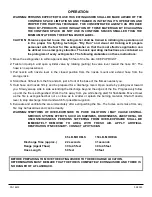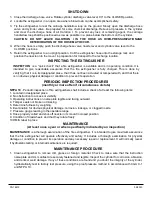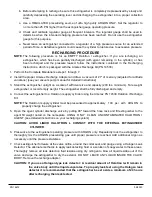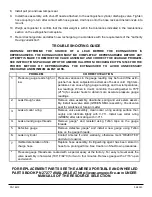
PN 16672
04/2020
INTRODUCTION
This manual covers specific instructions for the Amerex wheeled stored pressure Halotron1 fire extinguishers.
Special maintenance and recharge instructions contained in this manual apply to these extinguishers only.
Halotron l
“
Clean Agent
”
extinguishers are designed for Class A, B, and C hazards formerly protected with
Halon 1211 extinguishers. They contain dichlorotrifluoroethane (R
-
123), which is designated for streaming fire
extinguisher applications. Halotron l is listed in the U.S. Environmental Protection Agency (EPA)
“
Significant
New Alternative Policy
”
(SNAP) as acceptable for nonresidential applications. Halotron l has acceptable
toxicity and cardiac sensitization levels for use in occupied spaces when used according to the instructions on
the nameplate and rules of the EPA SNAP Program.
PHYSICAL PROPERTIES OF HALOTRON l
Primary Component
Dichlorotrifluoroethane (R
-
123) or (HCFC
-
123)
Boiling Point
80.6°F [27°C]
Liquid Density
92.3 lb./ft³ (1.48 kg / liter)
Gas Density
0.385 lb./ft³ (6.17 kg / m³)
Molecular Weight
150.7
Physical State
Pressurized Liquid
Vapor Pressure @ 68ºF [20ºC] (liquid alone)
11.2 psi [77 kPa]
Pressure of mixture in Container @ 68ºF [20º]
95 psi in bulk container
PREPARING YOUR NEW EXTINGUISHER FOR USE
1.
Remove all wrappings, straps and pallet retaining bolts.
2.
Examine the extinguisher for shipping damage.
3.
Check to insure that the hose connection at the discharge valve and the nozzle connection to the hose
are tight.
4.
Check to insure that the nozzle shut
-
off lever is in the CLOSED position. The pull pin shall be installed
and the tamper seal intact.
5.
Visually inspect the pressure gauge. The pressure gauge shall be in the green zone. Slight
pressure variances in the gauge reading may be found if the extinguisher has been subjected to extremes
of heat or cold. High temperatures can cause high gauge readings and low temperatures, low readings.
When in doubt, condition the extinguisher to 70ºF (21ºC) for several hours to obtain more accurate
pressure gauge readings.
6.
The method used to determine proper agent fill is by weighing the extinguisher. The gross weight is
marked on each extinguisher nameplate.
7.
Record the date the unit is being placed into service on the inspection tag and attach it to the extinguisher.
INSTALLATION
Do not place this extinguisher close to a potential fire hazard. Amerex recommends a location no less than a
50
-
foot distance from the hazard while leaving an unobstructed access. Avoid placing it in an extremely hot or
cold area. The operational temperature range for this extinguisher is –
40
°F to 120°F (
-
40°C to 49°C). The
extinguisher shall be adequately protected if temperatures outside of this range are anticipated. Keep the
extinguisher clean and free from dirt, ice, chemicals and any contaminants that may interfere with its proper
operation. DO NOT FUNCTIONALLY TEST THIS FIRE EXTINGUISHER. (Testing or any use may cause the
extinguisher to gradually lose extinguishing agent over a period of time and make the extinguisher
ineffective.)









